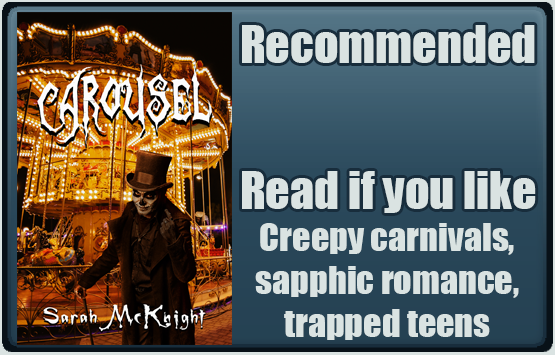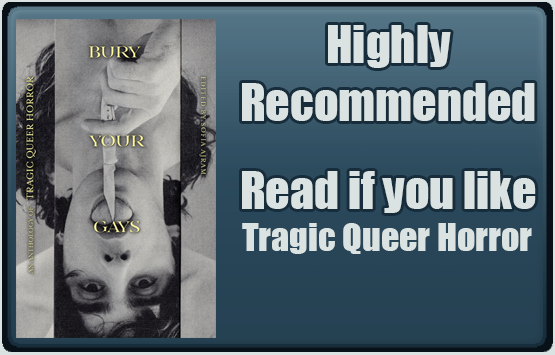Formats: Print, digital
Genre: Body Horror, Ghosts/Haunting, Killer/Slasher, Monster, Romance
Audience: Adult/Mature
Diversity: Queer and trans authors and characters
Content Warnings: Alcohol Abuse, Body Shaming, Bullying, Death, Drug Use/Abuse, Eating Disorder, Homophobia, Medical Torture/Abuse, Medical Procedures, Necrophilia, Police Harassment, Rape/Sexual Assault, Slurs, Suicide, Torture, Transphobia, Violence (Highlight to view)
Blurb:
| A manifestation of ecstasy, heartache, horror and suffering rendered in feverish lyrical prose. Inside are sixteen new stories by some of the genre's most visionary queer writers. Young lovers find themselves deliriously lost in an expanding garden labyrinth. The porter of a sentient hotel is haunted within a liminal time loop. A soldier and his abusive commanding officer escape a war in the trenches but discover themselves in an even greater nightmare. Parasites chase each other across time-space in hungry desperation to never be apart. A graduate student with violent tendencies falls into step with a seemingly walking corpse. Featuring stories from Cassandra Khaw, Joe Koch, Gretchen Felker-Martin, Robbie Banfitch, August Clarke, Son M., Jonathan Louis Duckworth, M.V. Pine, Ed Kurtz, LC Von Hessen, Matteo L. Cerilli, November Rush, Meredith Rose, Charlene Adhiambo, Violet, and Thomas Kearnes. |
I received this product for free in return for providing an honest and unbiased review. I received no other compensation. I am disclosing this in accordance with the Federal Trade Commission’s 16 CFR, Part 255: Guides Concerning the Use of Endorsements and Testimonials in Advertising.
An exquisite anthology of queer horror that boasts such
talented authors as Cassandra Khaw, August Clarke, and Gretchen Felker-Martin,
this collection contains something for everyone. In its pages, you’ll find
alien fungi, body horror, dark fairytales, undead lovers, and lonely ghosts.
Named for the common trope where gay characters often meet with untimely ends
in mainstream media, this anthology subverts the trope by putting it in the
hands of queer writers.
In Your Honor, I’d Like to Put You in the Shoes
of One of Dr. Morehouse’s Thirty Proven Clients by M. V. Pine, a trans
woman (although she’s never referred to as such) struggles to find gender-affirming
care. It’s the 1970s and she’s been dishonorably discharged from the army for
“mental health” reasons. Her family doesn’t support her. She refers to her
genitals as “a tumor.” A tumor that’s benign (hence, no doctor will remove it
for her) but still mortifying. Because she’d do anything to be rid of it, she becomes
an easy mark for Dr. Morehouse, who performs dangerous back-alley vaginoplasties
on trans women. His surgical room is dirty and he runs out of anesthesia
halfway through the procedure. He doesn’t provide antibiotics or pain
medication. But the woman would rather die than go another day living with her
“tumor.”
This is a story is about what happens when people don’t have
access to safe, gender-affirming care. In
2017 a trans woman known only as “Jane Doe” underwent a back-alley orchiectomy
which caused her to lose large amounts of blood. Police arrested James Lowell
Pennington, who had performed the procedure without a medical license. Doe
defended Pennington stating "Arranging a back-alley surgery was out of
pure desperation due to a system that failed me.” Why would someone risk their
life for what seems like an elective procedure? A study published
in JAMA that followed trans and non-binary youths ages 13 to 20 showed
60% reduction of depression and 73% reduction of suicidality in participants
who had initiated puberty blockers and gender-affirming hormones compared to
those who had not. Another
study published in JAMA on gender-affirming surgeries among 27,715 trans
and gender diverse adults showed a 42% reduction in psychological distress and
a 44% reduction in suicidal ideation among those who were able to receive
gender-affirming surgery compared to those who wanted to but could not. There
are many such studies that show similar results. Access to safe, gender-affirming
care is quite literally lifesaving and immensely improves quality of life for
trans and gender diverse people.
Another story that touches on the desperation many trans
people feel just to have access to gender-affirming care is Worth the Dying Shame by Matteo L.
Cerilli. In it, trans men are being infected by tainted, counterfiet
testosterone with a disease that causes their bodies to decay as if dead (a
clear parallel to AIDS). They hide their Body Rot under heavy clothing, dark
glasses, and face masks. This causes an already unaccepting public to further
turn on trans men. With jobs drying up, friends abandoning them, and doctors no
longer willing to prescribe testosterone, the men who are able togo
back in the closet. Others are forced to buy their T on the black market since
doctors are no longer willing to prescribe the real stuff, which carries an
even greater risk of infection. The story follows two trans men who have become
infected, Dimeshine and Rictus. Rictus chose to detransition because he can
still pass for a girl, but Dimeshine continues to inject T despite the risk of
decaying faster. Both turn to the dark web to try and slow their Body Rot,
trusting the community more than they do hospitals (understandable considering
how often healthcare fails trans people). The two argue over whether
Dimeshine’s little brother, Ratty, who is still early in his transition, should
use testosterone or not. Dimeshine is firmly against it, worried Ratty might
become infected like he was, but Rictus argues that he can’t blame Ratty for
wanting to die for something they both would have killed for. These stories are a solemn reminder of what
happens when the healthcare system fails LGBTQIA+ patients. As someone who
works in healthcare, I held both stories especially heartbreaking.
Surprisingly
for a horror anthology, many of the stories were love stories. Editor Sofia
Ajram states the collection “was created out of a desire to read stories about
tragic queer love. Love that is broken, love that is toxic, and obsessive, and
ill-fated. Love that is thwarted, as viewed through the lens of authors who are
queer-identifying themselves.” Abusive relationships are too often played off
as romantic (think Twilight and Hush Hush), so it’s nice to see
those sorts of relationships being shown for what they are, even when the
characters themselves can’t recognize it. While horrific in real life, villain
protagonists and toxic relationships can be fascinating studies in fiction. I
also enjoyed having imperfect, even villainous queer characters whose character
faults aren’t tied to their sexuality.
In American Gothic by LC von Hessen,
villain protagonist John Smith is a serial killer (although he’d never refer to
himself as such since “those guys are losers”) who has an unfortunate habit of
murdering his dates. It’s not premeditated, it just seems to happen. But one
day, one of his victims, who he dubs “L,” comes back to life. Or rather, he
reanimates, as he’s still technically dead. L has no memory of his time alive,
so John weaves an ever changing, fictional history of their romance. As L
slowly rots away, John falls deeper in love with him. As shown with his past
crushes, John is more in love with the fantasy he conjures then the men
themselves. L allows him to project his ideal partner on to a blank slate he
can fall in love with, like some sort of twisted Pygmalion, whereas living men
would frequently reject him for being unemotional or creepy. John is a selfish
lover, viewing his partners only by what they can do for him rather than their
needs. He stalks and harasses one of his exes to the point they delete all
their social media, but John still views himself as the victim and wonders why
he didn’t kill his ex. John wants L to live, not for L’s sake, but for his own.
He even tells him, “I won’t let you die. You’re not allowed to die unless I
want you to die.” His selfishness and obsessiveness reminded me of male
stalkers who feel they’re owed something by the object of their affection and
can’t understand the word “no.”
This Body is Not Your
Home by Son M., Love Like Ours by
C M Violet, and Fortune Favors Grief
by Cassandra Khaw are also stories of men who kill their lovers. Domestic
violence against men is rarely examined. Even though 1
in 10 men will experience intimate partner violence or stalking in their
lifetime, DV is usually thought of as a women’s issue only. Research on
domestic violence among LGBTQIA+ people is even more sparse, even though gay
men experience higher rates of physical violence then straight men. So,
it’s refreshing to see stories that focus on intimate partner violence in gay
relationships. Some of the stories focus more on mental and emotional abuse
rather than physical. Both Sardines
by Gretchen Felker-Martin and Zero
Tolerance by M. F. Rose deal with queer teenage girls who are bullied. The
former is a body horror story about a fat girl struggling with her sexuality
and the latter is about cyber bullying. In this case, it’s their non-romantic
relationships that are toxic.
Cleodora by August
Clarke is a more lighthearted tale that follows the romance between a beautiful
sea monster and a sea captain. The Captain discovers the monster and claims her
as her bride, naming her Cleodora after a prophetic river nymph (The Captain
seems to conflate the nymph Cleodroa with Andromeda, a princess who was offered
as a sacrifice to a sea monster and rescued by the Greek hero Perseus). She
sees Cleodora as helpless, which may explain why the Captain has no qualms
about marrying a monster, happily feeding her new bride live eels and listening
to her stories of drowning men. Cleodora feels equally unthreatened, stating
“It’s fortunate my true love is a woman, because women do not hurt each other.”
Ironic, considering how the story ends. The story feels like the original,
darker version of a German fairytale, with hints of selkie wife folklore and
siren myths.
Not all the
romances involve toxic relationships or unrequited love. Bad Axe by Ed Kurtz is a tragic love
story wherein John loses his lover, Eric, to the lake at Bad Axe in Minnesota.
They’re never able to recover the body, so John goes back to Bad Axe to drown
himself so he can be with Eric again. A touching yet morbid story it shares
similarities with the myth of Hero and Leander. Hero, a priestess of Aphrodite,
throws herself out of her tower after her lover, Leander, drowns trying to swim
to her. The tragedy in Bad Axe is that John and Eric have a beautiful
relationship that was tragically taken from them and now John must try and
navigate the world through his immense grief. Black Hole, a sci-fi story by November Rush, also centers around a
beautiful relationship that’s torn apart, but this time it’s between two
parasitic, sentient fungi. Despite not being human, their love is no less pure
and real. Lost and Found by Charlene
Adhiambo also deals with lovers being united in death, but in this case they didn’t
know each other before they died.
It’s an intense read-- many of the stories handle dark themes
like transphobic healthcare systems, bullying, drug abuse, suicide and AIDS
analogies--but a beautiful one, full of romance and tragedy. Remarkably, each
one of the stories in Bury Your Gays is as strong as the last, and I’d
be hard pressed to pick a favorite. Some broke my heart, others chilled me to
the bone, and yet others were touching in a bittersweet way. But all left a
lasting impression.

